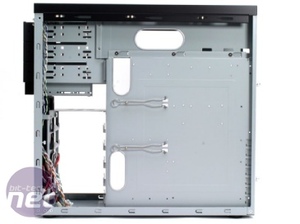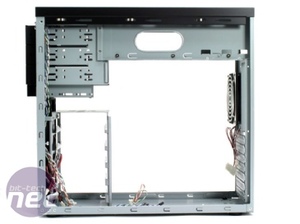Metal Guts K7
Its easy to get inside the Metal Boned K7 and, just for once, I have to say I enjoyed not having to fiddle around with connected fans in the side panels of the case and large, flimsy windows. Stripping the Metal Boned K7 down to it’s bare, metal bones was just a case of undoing two thumbscrews.Well, ok, that’s not strictly true – it was a case of removing six thumbscrews; two for each side panel and then another two for the…removable motherboard tray!
I tell you, it may not sound like much and you may well dismiss the notion of a motherboard tray that you can add in and take out as you need. Let us assure you thought that when you spend as much time as we do dipping in and out of cases to add, remove, threaten, stab and punch various pieces of malfunctioning hardware then a removable motherboard tray can save you tons of hassle.
In fact, the tray used in the Metal Boned K7 is better than most other trays we’ve used as it also features an excellent cable routing system, both with gaps for you to funnel wires through and with two large clips on the back which you can clamp errant braids with.
Unlike other motherboard trays which slide out the back of the case, usually somewhat awkwardly and with plenty of metal-on-metal grinding noise, this just falls out backwards from the rear side. Yes, it does require the second side panel being removed and all those neat cables you've got clipped in on the back need to be taken out too, but it seems to be better for it, forcing you to re-organise things to maintain an airflow maximised and cleaner looking interior. Working inside the case isn't a huge danger anyway - all the corners and edges are blunted off to avoid scratches.
The Metal Boned K7 is pretty serious in other areas too, not just accessibility. This whole-hearted and full-on approach to every thing has some interesting side effects though when combined with the small size and unassuming design.
It occurs to us that if the Metal Boned K7 were a living creature then it’d probably be Serious Cat; because sure, this case is seriously designed, but it’s also just the tiny bit diminutive and adorable. Geeks look at it and go awww.
In terms of cooling (kittens hate hot weather) the Metal Boned K7 has a single 120mm exhaust fan at the back. There are two more 120mmers in front of the HDD cage too and each of these has a separate air filter beneath the bezel which can be easily removed. The front-panel of the case comes off with just a hard tug too, so the entire case is tool-less right down to the 5.25” drive bays. Both set of fans run at a very low 500 RPM and seem to be ball bearing fans, which last longer but are generally noisier than some alternatives.
The only real downside to the fans though in our opinion is the width - in the front of the case there's only room for fans with a width of 15mm, which may limit you if you want to use thicker, slower fans instead. There's also no in-built fan control, though that is probably a minor concern for most.
The HDD cage is pretty snazzy as it uses the same system of anti-vibration drive locking as the Lian-Li PC-B25. This cage can also be rotated through 180 degrees if you’re having trouble with cables, though the method for doing this isn’t entirely as easy as Lancool would probably want you to think.
One more thing which it took us a few moments to notice were the cable clips which had been stuck in to the top of the case, allowing all the internal connectors to be fastened out of the way. The clip itself is attached to the ceiling of the chassis simply and, actually most cases come with clips like this included – but not already attached. That someone at Lancool has taken the time to put them in place is a subtle, but appreciated touch.
Now, by this stage some of you might be wondering if the size of the case is a problem at all for the power supply and graphics cards – and you’d be right to do so since the case certainly doesn’t have an awful lot of room to spare.
We did a little bit of checking on this and found that as far as graphics cards go there is just about enough room. You can certainly get an Nvidia 8800 GTX in there with an inch to spare between the card and the HDD cage - just enough for a PCI-E connector.
Large PSUs on the other hand may be more of a problem and you may find yourself force to invest in a PSU extended bracket from Lian-Li if you’ve got a truly gargantuan generator in your system (an Enermax Galaxy for example).

MSI MPG Velox 100R Chassis Review
October 14 2021 | 15:04













Want to comment? Please log in.